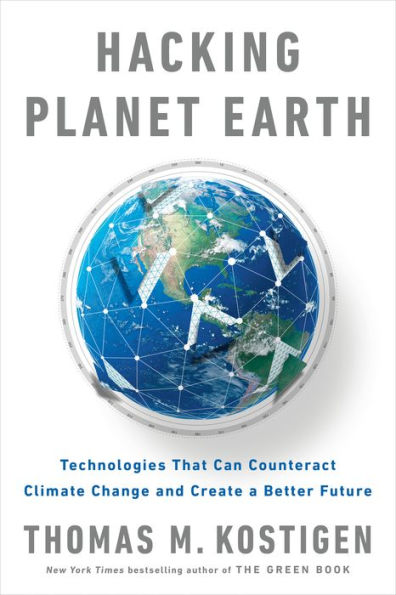Hacking Planet Earth: Technologies That Can Counteract Climate Change and Create a Better Future
An exploration of the cutting-edge technology that will enable us to confront the realities of climate change.
For decades scientists and environmentalists have sounded the alarm about the effects of global warming. We are now past the tipping point. As floods, storms, and extreme temperatures become our daily reality, "Reduce, Reuse, Recycle" efforts aren't enough anymore. In Hacking Planet Earth, New York Times bestselling author Thomas Kostigen takes readers to the frontlines of geoengineering projects that scientists, entrepreneurs, engineers, and other visionaries around the world are developing to solve the problems associated with climate change.
From giant parasols hovering above the Earth to shield us from an unforgiving sun, to lasers shooting up into clouds to coax out much-needed water, Kostigen introduces readers to this inspiring work and the people who are spearheading it. These futurist, far- thinking, world-changing ideas will save us, and Hacking Planet Earth offers readers their new vision for the future.
1139853917
For decades scientists and environmentalists have sounded the alarm about the effects of global warming. We are now past the tipping point. As floods, storms, and extreme temperatures become our daily reality, "Reduce, Reuse, Recycle" efforts aren't enough anymore. In Hacking Planet Earth, New York Times bestselling author Thomas Kostigen takes readers to the frontlines of geoengineering projects that scientists, entrepreneurs, engineers, and other visionaries around the world are developing to solve the problems associated with climate change.
From giant parasols hovering above the Earth to shield us from an unforgiving sun, to lasers shooting up into clouds to coax out much-needed water, Kostigen introduces readers to this inspiring work and the people who are spearheading it. These futurist, far- thinking, world-changing ideas will save us, and Hacking Planet Earth offers readers their new vision for the future.
Hacking Planet Earth: Technologies That Can Counteract Climate Change and Create a Better Future
An exploration of the cutting-edge technology that will enable us to confront the realities of climate change.
For decades scientists and environmentalists have sounded the alarm about the effects of global warming. We are now past the tipping point. As floods, storms, and extreme temperatures become our daily reality, "Reduce, Reuse, Recycle" efforts aren't enough anymore. In Hacking Planet Earth, New York Times bestselling author Thomas Kostigen takes readers to the frontlines of geoengineering projects that scientists, entrepreneurs, engineers, and other visionaries around the world are developing to solve the problems associated with climate change.
From giant parasols hovering above the Earth to shield us from an unforgiving sun, to lasers shooting up into clouds to coax out much-needed water, Kostigen introduces readers to this inspiring work and the people who are spearheading it. These futurist, far- thinking, world-changing ideas will save us, and Hacking Planet Earth offers readers their new vision for the future.
For decades scientists and environmentalists have sounded the alarm about the effects of global warming. We are now past the tipping point. As floods, storms, and extreme temperatures become our daily reality, "Reduce, Reuse, Recycle" efforts aren't enough anymore. In Hacking Planet Earth, New York Times bestselling author Thomas Kostigen takes readers to the frontlines of geoengineering projects that scientists, entrepreneurs, engineers, and other visionaries around the world are developing to solve the problems associated with climate change.
From giant parasols hovering above the Earth to shield us from an unforgiving sun, to lasers shooting up into clouds to coax out much-needed water, Kostigen introduces readers to this inspiring work and the people who are spearheading it. These futurist, far- thinking, world-changing ideas will save us, and Hacking Planet Earth offers readers their new vision for the future.
18.0
In Stock
5
1

Hacking Planet Earth: Technologies That Can Counteract Climate Change and Create a Better Future
352
Hacking Planet Earth: Technologies That Can Counteract Climate Change and Create a Better Future
352Paperback
$18.00
18.0
In Stock

Product Details
| ISBN-13: | 9780525538356 |
|---|---|
| Publisher: | Penguin Publishing Group |
| Publication date: | 10/12/2021 |
| Pages: | 352 |
| Sales rank: | 186,455 |
| Product dimensions: | 5.90(w) x 8.90(h) x 1.10(d) |
About the Author
From the B&N Reads Blog
